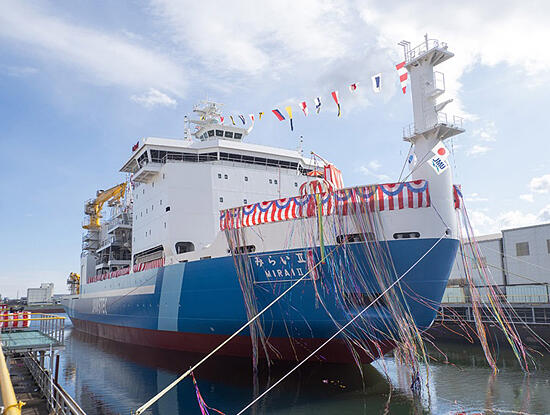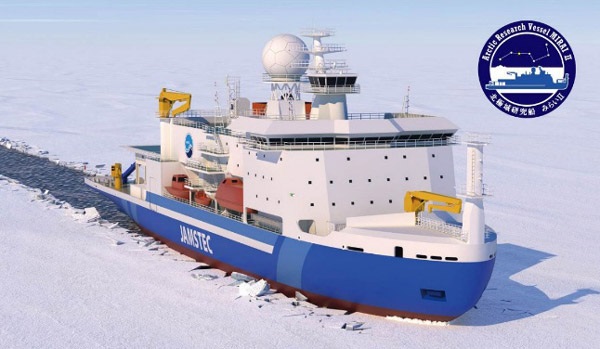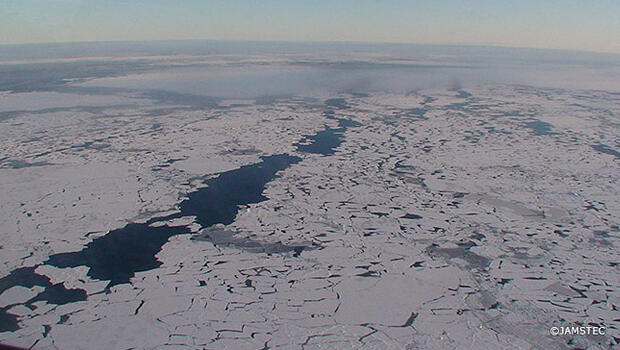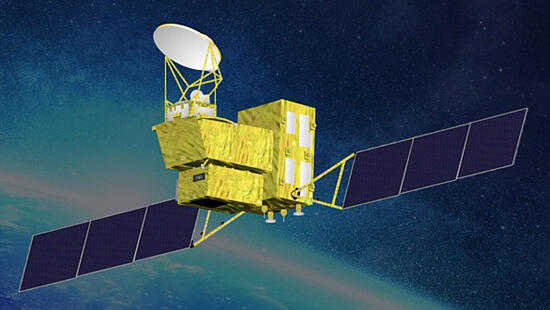A new observation vessel by the Japan Agency for Marine-Earth Science and Technology (JAMSTEC) for Arctic region research is under construction. It was officially named "Mirai II" at its launch ceremony, and preparations continue toward delivery next November. Its most significant feature is being the first research vessel in Japan with icebreaking capabilities, set to become the cornerstone of Arctic region observations deeply involved in global climate change. It was recently revealed that the winter sea ice area was the smallest in history. Amid concerns, there are increasing expectations for Mirai II to unravel the true face of the Arctic.

Provided by JAMSTEC
"Filling the blank spaces in the data"
Mirai II is planned to be 128 meters long and 23 meters wide, with a gross tonnage of 13,000 tons and capacity for 97 crew members. The construction cost is 33.9 billion yen. Shipbuilding giant Japan Marine United (located in Yokohama City) began construction in August 2021 at its Isogo Ward factory. On March 19, the launch ceremony was held, with Princess Aiko, eldest daughter of the Emperor and Empress, in attendance, cutting the mooring ropes with an axe for the launch. Interior work and equipment installation will be performed later in the construction process.
This research vessel is the successor to the current ocean research vessel "Mirai." Mirai, which was converted from Japan's first nuclear-powered ship "Mutsu " and completed in 1997, has served as one of the world's largest ocean observation vessels, surveying the Arctic Ocean, Pacific Ocean, and Indian Ocean. While the original ship had excellent ice-resistance and navigation performance, it lacked icebreaking capabilities and couldn't penetrate sea ice zones. In contrast, Mirai II can continuously break through flat sea ice up to 1.2 meters thick while moving at 3 knots (5.6 km/h). It has Polar Class 4 classification, providing sufficient icebreaking and ice-resistance capabilities.
Director Eisuke Akane of the Project Office for Arctic Research Vessel (PARV) at JAMSTEC, explains, "The Arctic might seem distant from us, but its changes affect the entire globe, including Japan. Predictions of changes vary significantly between countries, necessitating detailed observations. We aim to lead international observation projects with Mirai II to fill blank spaces in the data and contribute to solving various challenges."

Provided by JAMSTEC
According to Akane, unusually for a research vessel, Mirai II will use a dual-fuel engine capable of running on both conventional diesel and LNG (liquefied natural gas). It will be equipped with Doppler radar for meteorological observations, fish finders, remotely operated underwater vehicles, helicopters, and a "man-riding basket" to transport researchers onto sea ice, implementing "all-round observation research capabilities for weather, ocean, and sea ice in various maritime areas."
The Antarctic observation vessel of the National Institute of Polar Research (NiPR) "Shirase," operated by the Japan Maritime Self-Defense Force, is used as a naval icebreaker, primarily for transporting materials and personnel. Mirai II is considered Japan's first research vessel with icebreaking capabilities.
Sea ice "underfloor heating," northern sea route... Research challenges accumulate
Unlike the Antarctic continent, the Arctic region is predominantly sea, with the North Pole located on frozen seawater. In January, a research group from JAMSTEC, Hokkaido University, Tokyo University of Marine Science and Technology and other organizations revealed that warm water from the Pacific is flowing underneath the sea ice, accumulating heat noticeably in certain areas where this was previously rarely reported. This heat could potentially melt sea ice like an "underfloor heating" system. Deputy Director Takashi Kikuchi of JAMSTEC's Institute of Arctic Climate and Environment Research stated, "We must carefully investigate where this heat comes from and how it interacts with sea ice."
Other research challenges include understanding sea ice formation and melting processes around polar nights, investigating how soot from global forest fires transported to the Arctic atmosphere might accelerate ice melting or serve as cloud nuclei, and exploring the Arctic Ocean's history.
The Northern Sea Route connecting the Atlantic and Pacific Oceans opens during part of summer when sea ice melts, offering a significantly shorter path compared with Egypt's Suez Canal. Satellite observation data is crucial for determining passage feasibility. However, satellite data might indicate impassability, while local ice conditions and ship classifications could permit passage. "Differences between sea ice conditions and satellite data are critical for navigation and require investigation," says Kikuchi.
Mirai II's observation plans will be developed collaboratively by JAMSTEC and the NiPR. Preliminary plans include targeting the North Pole on its first Arctic voyage in 2027 and preparing for the Fifth International Polar Year in 2032-2033. The plans for each year are becoming more concrete and will tackle these research challenges. There will also be a focus on personnel training for long-term vessel operation.

Provided by JAMSTEC
Sea Ice Area at Minimum — Continued Monitoring from Space
On March 20, the winter Arctic sea ice area reached its annual maximum of 13.79 million square kilometers, the smallest in satellite observation history, as announced last month by a research group from the Japan Aerospace Exploration Agency (JAXA) and the NiPR. This was determined from 47 years of observation data from domestic and international satellites, including the Global Change Observation Mission- Water "SHIZUKU," operational since 2012.
JAXA President Hiroshi Yamakawa stated at a press conference, "The reduction of the Arctic sea ice area raises concerns about meteorological and marine environmental impacts. This result reaffirms the critical importance of continuing the collection of observation data and research analysis. We want to further contribute to climate change monitoring."
For the sea ice area analysis using SHIZUKU, the high-performance microwave radiometer "AMSR-2" onboard is utilized. It captures microwaves, a weak electromagnetic wave radiated from the Earth's surface, sea surface, and atmosphere. JAXA, the Ministry of the Environment, and the National Institute of Environmental Studies will launch its successor, the Global Observing SATellite for Greenhouse gases and Water cycle "GOSAT-GW," carrying "AMSR3" with expanded observation wavelength bands, next month on the 50th and final H2A rocket.

Provided by JAXA
While the Syowa Station activities and observation team's Sakhalin dogs, featured in movies, have made a strong impression of the Antarctic on many modern Japanese people, the Arctic might seem more distant. Many people are likely aware of the observation vessel Shirase but lack knowledge of the Mirai. However, historical figures like Nobu Shirase (1861-1946), known for his Antarctic exploration, initially aimed for the Arctic, demonstrating Japan's long-standing passion for northern exploration. We hope that observation means Mirai II and other projects will inherit this spirit and contribute to humanity's future, true to its name.
(KUSAKA Takeo / Science Portal Editorial Department)
Original article was provided by the Science Portal and has been translated by Science Japan.




